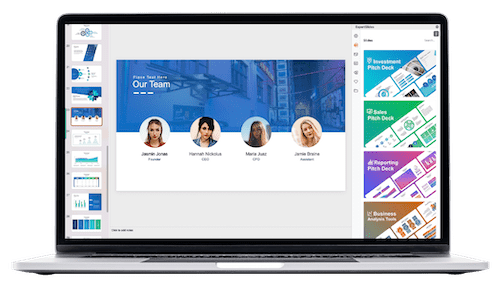How Do You Introduce Yourself In A Presentation?
Table of Contents
Introducing yourself in a presentation is an important skill that not only sets the tone for your entire speech but also helps to establish credibility and build rapport with your audience. It can be a nerve-wracking experience, especially if you are speaking in front of a large crowd or presenting to people you don’t know well.
There are many different ways to introduce yourself in a presentation, and the approach you choose will largely depend on your personal style and the context of the presentation. In this guide, we will explore some effective strategies for introducing yourself in a presentation and provide tips to help you make a great first impression.
Why is it important to introduce yourself in a presentation?

When you introduce yourself at the beginning of a presentation it’s crucial for making a bond with them people listening and showing that you knows what they’re talking about. This lets you gives off the right vibe from the get-go and grabs your audience interest right away. Plus, it make a friendly link between you and them folks in their seats which might makes them listen better to what you have to says.
As you’re starting to talk about yourself, you give important background for the points you going to make and let the peoples listening get to know what kind of individual you is. This do a lot for making folks trust you and think that they knows enough about your subject. It even makes them feel like they’re more in tune with what’s being said getting their attention better.
One crucial reason for telling who you is in a talk is to make a first impression that shape how peoples sees you and the things you’re going to say. A solid and sure beginning can put trust in your listener and make them more ready to listen careful to your words.
Introducing yourself in a presentation also help break the ice and ease tension or nervosity that might be between you and the audience. This especially important if you presenting to peoples you don’t know well or in formal setting.
Moreover, when you introduce yourself during a presentation it’s seen like showing respect to the audience. It show that you values their time and is happy to make a personal connection with them before you starts on the main points of your talk.
Can You tailor his intro for various talks?
Absolutely you can and must tailor you intro based on the situation of your talk. How you present yourself in a formal business presentation might differ from the way you do it in a more relaxed environment or while delivering a speech at social gathering.
First you got to think about who the audience is that gonna be hearing your talk. They pros, students or some of both? Knowing them helps you decide how formal and what kind of tone your introduction should have.
You should also considers why you giving your presentation. It for to inform persuade or to entertain? Tailoring yours introduction so it fit with the main objective of your speech can help you catching and keep the interest of audience.
Moreover you can personalize your opening by weaving in personal stories or pertinent details that relates to your particular crowd. This helps forge a deeper bond and makes them more interested on what you wants to share.
Finally, when you thinks about the main subject or idea of your speech ask yourself is it somber and formal topic or something more cheerful? Your beginning must mirrors the tone of your talk and offer listeners a sneak peek of what to expect.
Benefits of a good introduction in a presentation

A good introduction can have numerous benefits for both the speaker and the audience. For the speaker, it sets the stage for a successful presentation by establishing their credibility, building rapport with the audience, and creating a positive first impression.
Introducing yourself effectively also helps to capture and maintain the attention of your audience. This is especially important in today’s fast-paced world where people have shorter attention spans and are easily distracted. A strong introduction can hook your audience and make them more likely to stay engaged throughout your speech.
For the audience, a well-crafted introduction can provide valuable context for the presentation and give them an idea of what to expect. It also helps to establish a personal connection with the speaker, making them more likely to trust and connect with the message being delivered.
Moreover, a good introduction can also help to create a positive atmosphere for the presentation. It can break down barriers between the speaker and audience, ease any tension or nervousness, and make everyone feel more comfortable and engaged with the speech.
In addition, an effective introduction can set the tone for the rest of the presentation. It can create a sense of anticipation and excitement, making your audience more receptive to your message and eager to hear what you have to say.
Furthermore, a good introduction can also help to establish the speaker’s authority and credibility on the topic being presented. This is particularly important in professional or educational settings where it’s essential to be seen as an expert on the subject.
Steps for delivering an impactful introduction

Start with a powerful opening statement
A compelling start to your talk is vital for a good intro. It create the mood and could either help or hinder they first opinion of you with them listeners.
Several methods is there for starting a presentation with strong opening words. You could start off by throwing a deep question, revealing a surprising number or telling an engaging short story that’s connected to your topic. This help grab the attention of your audience and pull them in right from the beginning.
A good method for starting they presentation is by picking a powerful quote or saying that establish the feeling for what you’re gonna talk about. This might be something to inspire, make people laugh or get them thinking hard, it really depends on why and what your speech is all about.
You could also uses humor as a opening statements for breaking the ice and creating lighter atmosphere. Just ensures that your jokes or humors is appropriate for you audience and align with overall tone of the presentation.
Also when you uses a bold picture or video as visuals aid it could be an effective method to begin your presentation. It grabs the audience’s attention right away and sets up what you gonna talk about. But ensure that visual aids is related and enhance value for your opener.
Give you name also important past details.
Once you has catched the audience’s eyes with a strong start it important for introducing oneself and build you credibility as speaker. Tell them your name job role or related background info which make you qualified for talking on the subject.
Building trust with you audience and giving them understand why you’re qualified to present on topic is something this can do. It also helps for making a personal connection by sharing stuffs about yourself that they relates to.
Nevertheless, take care to not talk too much or go into excessive specifics regarding you background. One should keeps things succinct and appropriate towards the presentation so as to not lose your listeners’ focus.
Offer a preview of your presentation
In you introduction it important that you gives the audience a quick summary of what they gonna expect from your talk. This helps them to better get the purpose and how your speech is set up.
You could do this through outline the main topic or point that you gonna cover in your presentation. It not only give audiences a sense of directions but also help creating smooth transitions into bodies of your speech.
Ensure to keep this preview short and don’t give away too many details. You aims to show the audience a snippet of what is coming but not unveiling all important specifics before they gets presented in you talk.
Share a personal anecdote or interesting fact
An other strategy for create bond with your audience and making your introduction more engaging be tell a personal story or a intriguing truth connect to what you’re talking about. It help in making yourself seem more approachable and give your talk a human touch.
Telling a tale or talking about an experience from you own life that relates back to your subject can also assist in forging an emotional bond with the audience. It make them feel more involved in what you’ve got to say and they more apt to recall what you spoken about.
Similarly sharing an obscure fact or a statistic tied to your subject can be a good way for sparking curiosity in you audience. This help set up why the presentation is significant and get them more keen to listen what you have say.
Keep it concise and to the point
Finally it’s important keeping your opening brief and direct. While making a strong impact matters, you also doesn’t want to spend too much time in your presentation on the introduction.
A helpful tip is keeping your intro between ten to fifteen percent of total time you’s got for they speech. This gives enough times to tell them why you’re talking hold the audience interest and lay down how the talk will feel without making them lose focus.
Steer clear from using lots of technical terms or difficult words in your opening, make it plain and easy for understanding so all people in audience can keep up.
Does an introduction always have to come first?
While a introduction is usually suppose to begin a presentation there might be some situation where it could work better to mix the starting order.
For instance if you is talking to a bunch who knows about you and what you gonna talk they might not need that you start with the usual opening. In this situation you could jump straight to the key parts of your talk.
In another case where you doesn’t need to introduce yourself at start is when you is part of presenting team or a panel.
Additionally, if there is a specific event or activity happening before your presentation, such as a guest speaker or performance, it may be more effective to begin with a short introduction after the initial event is over. This can help to keep the flow of the event and avoid any disruptions.
Ultimately, the purpose of an introduction is to capture and engage your audience’s attention while setting the tone for your presentation. If you can achieve this through a different approach, then an introduction at the beginning may not be necessary. However, it’s important to always consider the audience and the context of the presentation before deciding on the best approach.
Mistakes to avoid in an introduction
It’s equally crucial to keep a powerful and captivate start, but their is mistakes you got to steer clear of while making your beginning for the talk.
They makes a mistake by talking too much about themselves and doing self-promotion in they introduction. It’s needs to show why you is credible but it shouldn’t just talk about you. They should not make the start a big story of their life or like an ad for theyself.
Another error be that they uses clichés or overused sayings in their opening words. It makes introductions look the same and not surprising which might cause to loose interest of people listening. Instead try coming up with something special and catchy at start so you stands out from others speakers.
You should also stay clear from cracking jokes in your introduction except you’re sure about you comedic skills and understands that audience will like it. A joke what don’t work out might seem clumsy or could even upset people which can make for a bad start to your talk.
Finally make sure you don’t overstate or hype up you topic in the starting part. Doing so may lead to your audience expecting too much and it puts pressure on yourself for delivering a perfect talk. Rather be real about what you will talk about in your presentation and concentrate on giving worthwhile details instead of attempting to awe everyone.
You can make sure your presentation is successful and grabs the audience’s attention right from beginning by not making these errors in you introduction.
How to end an introduction on a strong note
Just like how crucial the start of you talk be, so do the end of your beginning matter too. How you shift from introduction to main part of speech set tone for rest of talk presentation.
A good way for finishing your introduction are to sum up what you gonna cover in the talk. It help give listeners a clear picture of what they should be expecting and makes a smooth change into the big ideas.
One method to finish strong be by posing a puzzling question or sharing a fascinating quote connected with you topic this helps grab the audience attention immediately and make them wonder about what’s coming up in your presentation.
You might finish you intro with a fierce claim or tell an interesting tale. It help grab your listeners attention and make emotional bond with them.
Also you could use your introduction for establish relevance and importance of them topic. By show why it matter and how it relate to they audience you make them more invested in what you got to say.
FAQs
What are the key points to include in a self-introduction during a presentation?
In a self-introduction within a presentation, it’s crucial to balance personal details with relevant professional information. Start with a brief introduction that includes your name, professional role, and why you’re speaking. Highlight key skills or experiences that connect directly to the presentation topic. This could involve a quick mention of a personal story or achievement that’s relevant to the audience. The goal is to generate interest and establish your credibility without diverting focus from the main subject of your presentation.
How can I make my introduction speech in a professional setting more engaging for audience members?
To make your introduction speech more engaging in a professional setting, try to incorporate elements that help the audience connect with you on a personal level. This could involve sharing a concise personal story or anecdote that relates to the broader topic of your presentation. Additionally, showing enthusiasm for the subject matter and expressing genuine excitement to share your insights can be contagious and help captivate your audience from the start.
What does a public speaking coach recommend including in an introduction to keep the audience focused?
A public speaking coach would likely recommend starting with a clear and concise statement of who you are and what you do, ensuring it’s directly relevant to the presentation topic. They might also suggest briefly mentioning a unique perspective or experience you bring, to set the stage for the value you’ll provide in your talk. Keeping your language simple and straightforward, while incorporating a hook that piques curiosity, can effectively keep the audience focused and eager to hear more.
Are there specific presentation skills that can enhance the way I introduce myself to an audience?
Yes, certain presentation skills can significantly enhance your self-introduction. First, practice clear and confident speech, paying attention to your pacing and intonation to keep it interesting. Use body language to your advantage by maintaining eye contact and using gestures that reinforce your words. Finally, tailor your introduction to your audience; consider what they might find most interesting or relevant about your background.
Conclusion
In conclusion, a strong and effective introduction is crucial for capturing the attention of your audience and setting the tone for your presentation. By keeping it concise, avoiding common mistakes, and ending on a strong note, you can ensure that your introduction makes a lasting impact on your audience.
Remember to always consider the context and audience when crafting your introduction and be willing to adapt if necessary. With these tips and techniques, you can confidently deliver an engaging and successful presentation from start to finish. So, always make sure to put in the effort to create a strong introduction that will leave a lasting impression on your audience.
Related Blogs
Get 7+ Mio. PowerPoint Assets - FREE SIGN-UP

Sign up for free to our PowerPoint extension, ExpertSlides. Everything you need, directly in PowerPoint. No credit card required.
Related Posts
